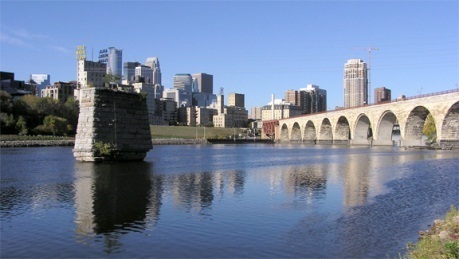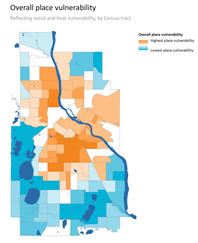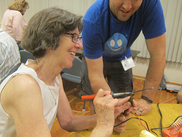|
Welcome to the Summer 2016 Minneapolis Sustainability Update. This quarterly newsletter contains resources, initiatives and opportunities to get involved.
This summer, fireworks aren't the only thing launching in the City of Minneapolis. Sustainability initiatives are taking off, as well. Minneapolis was selected by the Rockefeller Foundation to join the 100 Resilient Cities network. The Clean Energy Partnership released its first annual report to track progress toward the Minneapolis Climate Action Plan goals. The Green Zones Workgroup continues to refine its vision and strategies for environmental justice in the city. And, the Sustainability Office recently released an assessment focused on social and landscape vulnerabilities to extreme heat/urban heat island effect and flooding from extreme rain events in Minneapolis.
Dip a toe into sustainability efforts in the coming months. Sign up for a Home Energy Squad visit, attend an upcoming event, purchase food from local and regional producers at one of Minneapolis's 40 farmers markets, or try out an energy saving thermostat. Thank you for your help and commitment to making Minneapolis a great place to work and play!
 The City was selected by The Rockefeller Foundation to join the 100 Resilient Cities network. The selection means Minneapolis will gain access to tools, funding, technical expertise and other resources to build resilience for the challenges of the 21st century, including factors such as growth, economics and disasters.
Minneapolis was chosen from more than 325 applicants. Selected cities are now part of a global community of cities working together to build urban resilience. In the months ahead, as part of the 100RC Network, Minneapolis will be eligible to receive grant funding to hire a Chief Resilience Officer, who will lead the citywide resilience-building process and engage stakeholders from across different government agencies, public and private sectors, and various communities to incorporate diverse perspectives and knowledge. Minneapolis will also receive technical support to develop a Resilience Strategy that reflects the city’s distinct needs, and the support and services they need as they work towards implementing that strategy.
 The Clean Energy Partnership has released the inaugural report on its groundbreaking clean energy initiative. The report highlights the group’s efforts in creating the partnership structure, establishing the first two-year work plan and adopting baseline metrics measuring progress in the Partnership’s first year. It also creates a more complete picture of the city’s greenhouse gas profile related to buildings and energy production, consumption and savings opportunities. Results will be tracked and reported annually.
The first year focused on creating the Energy Vision Advisory Committee, establishing partnership procedure and structure, developing a work plan and putting metrics into place. The Partnership also began some coordinated outreach promoting energy efficiency and renewable energy options for Minneapolis businesses and residents. Highlights ranged from Xcel Energy and CenterPoint Energy spending more than $1 million combined to help low-income customers improve the energy efficiency of their homes to a 40 percent increase in rooftop solar installations in 2015. Read the full report to learn more about the Clean Energy Partnership's accomplishments.
|
 The Minneapolis Green Zones Workgroup has met three times since its creation in April 2016, focusing on laying groundwork for developing a vision and goals for what a Minneapolis Green Zones initiative should look like. The next meeting will provide an environmental justice training, starting to investigate Minneapolis environmental health data and Green Zones examples in other cities.
The following meeting will build upon previous dives into unconscious bias, racism and environmental justice to develop a vision and goals for Minneapolis Green Zones. Meetings are open to the public. Find meeting information, including agendas and past meeting minutes on the Minneapolis Green Zones webpage.
What is your vision for Minneapolis Green Zones? The Workgroup is seeking recommendations from the broader Minneapolis community to inform its vision process. Send your suggestions to kelly.muellman@minneapolismn.gov.
|
|
The City of Minneapolis collaborated with a group of Urban & Regional Planning graduate students from the Humphrey School of Public Affairs to conduct a Climate Change Vulnerability Assessment. Released in May 2016, the Assessment focused on the social and landscape vulnerabilities to extreme heat/urban heat island effect and flooding from extreme rain events.
Next steps are for the City to identify three communities in Minneapolis in which to conduct Community Climate Conversations. The goals of the Conversations are to build the capacity of local community leaders to understand the impacts of climate change and engage with residents on developing neighborhood-scale climate resilience solutions. The City will be partnering with Macalester College on the development of the engagement process and an evaluation, to take place in spring 2017.
View the final presentation and the technical document here.
|
|
 |
 The City of Minneapolis is providing grants for the nationally recognized ENERGY STAR certification. Similar to the idea of LEED certification, ENERGY STAR certification lets others know that your building uses energy efficiently and by becoming certified, you join the ranks of leading organizations such as Target, Wells Fargo and US Bancorp.
Be one of the first to earn apply for certification and receive $500 toward an $800 site visit completed by a professional engineer!
Certification benefits include:
- Plaque for your building providing transparency to building occupants
- Increased marketability of your well-run, energy efficient building to potential tenants
- Recognition on Minneapolis and ENERGY STAR websites
Visit the Minneapolis Building Benchmarking website for more information about the easy 4-step process required to become Energy Star Certified.
|
 For a limited time, the Minneapolis Clean Energy Partnership is collaborating with Xcel Energy and CenterPoint to offer FREE Home Energy Squad visits for income-qualified residents.
Your Home Energy Squad Enhanced visit will include two energy experts visiting your home for an hour and a half to two hours. Trained, energy-saving experts will identify places your home is losing energy and install materials to help start saving on the spot—plus show you easy ways to improve efficiency and reduce your utility bills. If the Home Energy Squad finds that your home needs insulation or air sealing, special 0% financing is available.
Learn more about how your home energy visit works.
|
 Local produce is nutritious and affordable. Many Minneapolis farmers markets also sell organic produce, as well as flowers and artisan food and gifts. Purchasing food from local farmers supports the local economy and helps farmers to retain their livelihood. Find 2016 location and schedule details for the nearly 40 Minneapolis farmers markets and mini-markets on the Homegrown Minneapolis farmers market page.
|
 Get free, guided assistance from handy volunteers on disassembling, troubleshooting and repairing small household appliances, clothing, electronics, mobile devices and more at an upcoming Fix-It Clinic.
Upcoming Fix-It Clinics are scheduled for the following dates and locations:
- Saturday, July 16 from noon to 4 p.m. at Minneapolis Community & Technical College in the H Building (Helland Center)
- Sunday, August 14 from noon to 4 p.m. at the Champlin Ice Forum
- Saturday, September 10 from noon to 4 p.m. at the Whittier Rec Center in Minneapolis
Volunteer fixers who have skills in electrical, mechanical or electronics repair, wood working, sewing or general tinkering are essential to making the clinics successful. For more information or to volunteer, contact Nancy Lo at nancy.lo@hennepin.us or 612-348-9195.
|
 Chickens are versatile – they lay high-quality eggs, feast on unwanted pests, and before you know it, can become beloved members of the family. Attend a free, self-guided chicken coop tour to vist coops and talk about chickens with your neighbors throughout the Twin Cities.
Saturday, September 17 from 10am to 4pm
Learn more details here.
|
 As part of the Conservation of Minneapolis Bees Project, the Minneapolis Health Department will plant 200 Healthy Bee Healthy Life (HBHL) pollinator patches throughout the city this year. The patches will include Minnesota native grasses, wildflowers, shrub, and trees. These diverse plantings will increase native habitat drastically lacking in the urban center and provide food and nesting materials for pollinators. The patches will also provide a forum for education and outreach to increase community awareness about the dwindling bee and pollinator population.
If you are interested in a pollinator patch for your home, multi-family building, business or community space, please contact Tiana Cervantes at EnvServicesInfo@minneapolismn.gov.
This project is made possible by Environmental Solutions for Communities grant sponsored by National Fish and Wildlife Foundation and Wells Fargo.
|
 Heating and cooling account for about 55 percent of the energy used in Minnesota homes. But you can trim those energy costs by simply resetting your thermostat when you are asleep or away from home.
A programmable or smart thermostat lets you do this automatically, with no worries about forgetting to turn it up or down.
Programmable thermostats can store and repeat multiple daily settings, which you can also manually override without affecting the rest of the daily or weekly program.
- Priced from about $20 to $150 (depending on features), it will likely pay for itself in energy savings after one year.
- In summer, set your thermostat as high as comfortably possible. Keep your house warmer than normal when you are away and then lower the thermostat setting to about 78 degrees when you are at home and want to stay cool.
- To maximize performance and efficiency, place thermostats away from direct sunlight, drafts, doorways, skylights and windows.
Smart thermostats operate essentially the same way as programmable models, with one significant difference: They “learn” your routines and preferences and adjust temperatures accordingly.
Because many homeowners with programmable thermostats actually fail to “program” them, a smart thermostat may be a better and more convenient option to achieve energy savings.
Check with your utility (or www.dsireusa.org) to see if it offers a rebate for programmable or smart thermostats. To watch a video on operating a programmable thermostat, visit ENERGY STAR web resources.
|